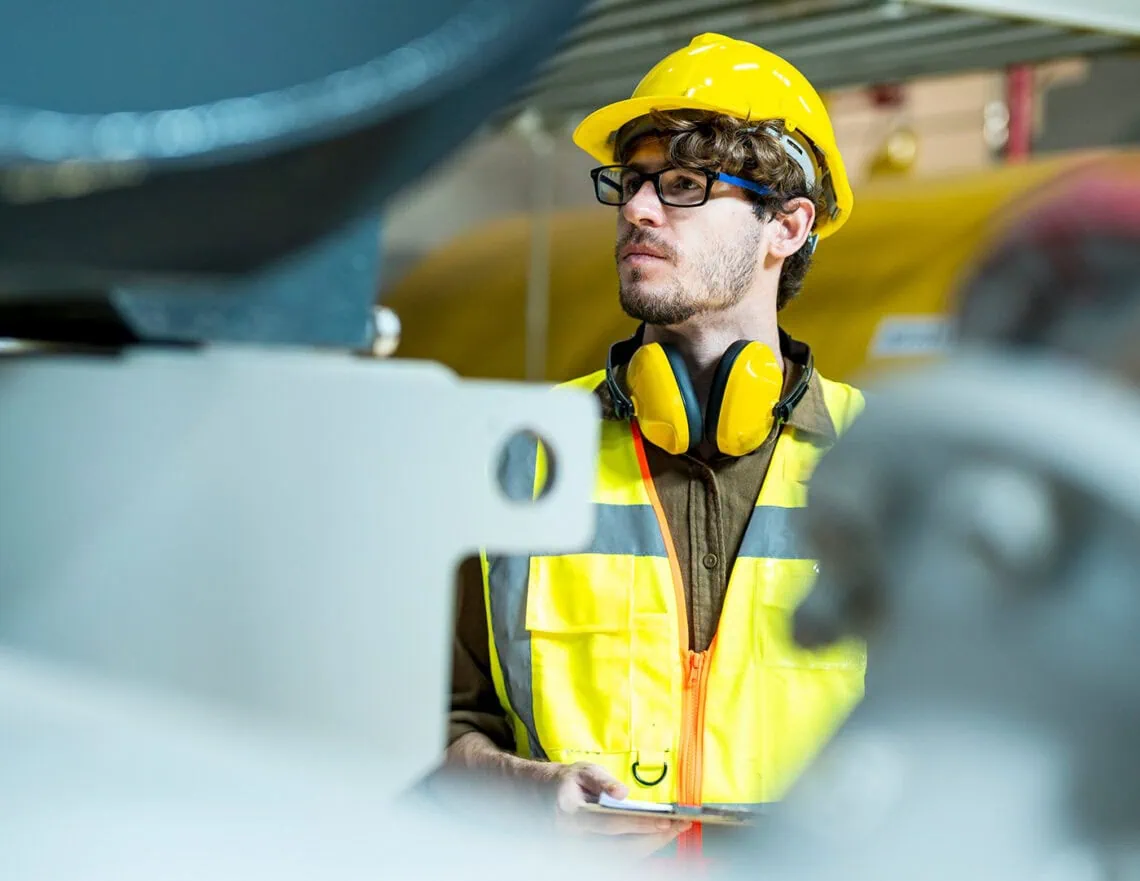
The manufacturing industry is undergoing a dramatic transformation driven by new technologies, evolving customer expectations and global economic shifts. To be positioned as tomorrow’s leaders and avoid lagging behind, companies within this sector must adapt swiftly.
Rimini Street’s Regional CTO, Han Law, shares 7 key manufacturing trends set to help redefine efficiency, product quality and sustainability in 2025. Strategically capitalize on these expert insights to achieve strong wins into the years ahead.
7 manufacturing trends that are driving change in 2025
1. Predictive maintenance: A step ahead of equipment failure
Predictive maintenance is no longer a novel concept. Gaining traction in recent years, it is expected to grow by 25% annually1, becoming an essential part of manufacturing operations. Using sensors, AI algorithms and data analytics, manufacturers can predict when a piece of equipment is likely to fail before it actually does. This proactive approach enables businesses to perform maintenance prior to a breakdown, minimizing downtime, reducing costly emergency repairs and extending equipment life.
One of the most notable manufacturing trends of 2025, predictive maintenance is expected to become even more precise and integrated into operations, allowing manufacturers to fine-tune maintenance schedules and improve overall equipment efficiency. The ability to address potential issues before they disrupt production is a major competitive advantage in today’s fast-paced manufacturing environment.
CTO insights: Seamless, real-time data orchestration across industrial IoT devices, machines and ERP systems is vital for predictive maintenance. It enables continuous data visibility and better insight to forecast equipment failures, reducing downtime and costs. Addressing technical debt and leveraging optimized ERP systems and hyperautomation, which combines AI and Robotic Process Automation (RPA), can accelerate execution and autonomous predictive maintenance operation. Further, a user-friendly UX ensures maintenance teams can act on predictive insights effectively, leading to more reliable, efficient operations.
2. Quality control and inspection: AI-driven precision
Quality control remains a cornerstone of manufacturing success. Traditional methods, often reliant on manual inspections, can be time-consuming and are prone to human error. But with advancements in AI and machine vision technologies, quality control is becoming more automated and precise.
Moving forward, AI-powered systems will be able to inspect products with accuracy and speed far beyond human capabilities. These smart systems continuously analyze production in real time, detecting defects, reducing waste and yielding a more consistent output with a level of precision that human inspectors can’t match. According to a McKinsey study, leveraging AI for quality control has the potential to lower manufacturing expenses by as much as 20%, translating to billions in savings globally.2 These technologies will become even more refined, driving overall efficiency and delivering superior products to market faster.
CTO insights: AI-driven quality control and inspection uses sensor data, machine vision and ERP systems, revolutionizing quality control by automating inspections, processing streaming analytics and AI, and enabling timely, corrective actions. These solutions are used for a wide range of scenarios including product classification, defect detection, product health recognition, package quality inspection and vehicle damage recognition.
3. Supply chain digitization and optimization: Smarter logistics
The supply chain is the backbone of manufacturing, but it’s also one of the most complex and vulnerable parts of the operation. Supply chain digitization is no longer a futuristic idea — it’s quickly becoming the industry standard. Manufacturers will increasingly rely on real-time data, artificial intelligence and blockchain technology to create more transparent, agile and efficient supply chains. These advancements will allow for:
- Better demand forecasting
- Real-time tracking of goods
- Enhanced visibility across the entire supply chain
A prime example is NGK Ceramics, a US-based manufacturer of ceramic products for vehicles that employs IoT-enabled tracking to oversee pallets within its facility, ensuring precise inventory control and streamlining logistics.3
With digital tools, manufacturers can more quickly identify disruptions, optimize inventory management and streamline logistics, ultimately reducing costs and improving delivery speeds. The shift toward digitized and optimized supply chains enables companies to respond more nimbly to market changes and external challenges such as material shortages or transportation delays — like the port congestion resulting from the 2024 port strike, which caused a rippling effect of shipping schedule issues and import holdups that can be seen even today. Digital solutions can help keep goods moving smoothly despite such unforeseen challenges.
CTO insights: Digital agility and resiliency drive smarter logistics by enabling real-time data orchestration across ERP data sources. Seamless integration unlocks predictive analytics, informed decision-making and AI-powered solutions for issues like supply chain disruptions, fraud and energy usage. Hyperautomation elevates efficiency by automating tasks, reducing errors and enhancing workflows. A well-designed UX also plays a crucial role by fostering adoption and boosting agility, ensuring a competitive edge in modern operations.
4. Autonomous logistics and transportation: Redefining the movement of goods
In a Deloitte study, more than 35% of manufacturers surveyed identified transportation and logistics expenses as a primary business challenge.4 Over the coming years, the logistics and transportation aspects of manufacturing will continue to be transformed by autonomous vehicles and drones. Self-driving trucks, drones and automated guided vehicles (AGVs) are expected to take over the task of moving goods within factories, warehouses and distribution centers.
Henkel, for example, a global company specializing in consumer goods and industrial solutions, uses drones in warehouses to take inventory and control packaging quality. In some locations, the company also incorporates self-driving forklifts, which handle recurring trips in production. 5
These autonomous systems should drastically cut transportation costs, improve safety and increase operational efficiency. Additionally, they’ll help alleviate some of the challenges posed by labor shortages in the logistics sector. With the rise of AI and machine learning, these autonomous solutions will become even more reliable and adaptable, reshaping how products are delivered and moved both within and between facilities.
CTO insights: Autonomous logistics and transportation — driven by AI, machine learning and IoT — are transforming the goods movement. Autonomous vehicles optimize routes in real time, reducing delays, saving fuel and enhancing flexibility. These systems help enable timely deliveries, improve safety by minimizing human error and lower environmental impact. As these technologies advance, they continue to redefine logistics with greater agility, resiliency, and sustainability.
5. Production planning and optimization: AI-enhanced decision-making
Gone are the days of relying on outdated spreadsheets and static schedules for production planning. AI-driven production planning is set to revolutionize how manufacturers approach scheduling and resource allocation. These intelligent systems can analyze massive datasets in real time to make dynamic adjustments to product plans. Variables such as raw material availability, demand fluctuations, machine downtime and even external factors like weather and geopolitical events can be factored in to adjust and optimize production schedules dynamically. This will allow manufacturers to respond to changes in demand with unprecedented flexibility and efficiency, reducing waste and maximizing throughput.
CTO insights: AI-enhanced production planning and optimization improves turn-around time, boosts production efficiency and reduces costs by integrating IoT devices, ERP, advanced planning and MES systems. A unified data platform enables real-time analysis, while predictive intelligence forecasts demand, capacity and materials for proactive adjustments. Hyperautomation with agentic AI helps ensure just-in-time optimization by reacting automatically to demand and production changes.
6. Smart manufacturing and IoT integration: The factory of the future
Smart manufacturing, fueled by the Internet of Things (IoT), is transforming factories into highly connected, data-driven environments. In 2025, IoT devices will be embedded in every aspect of the production process — machines, tools, inventory and even workers’ wearable devices. These sensors will continuously collect data, feeding real-time insights into centralized systems that can predict bottlenecks, optimize workflows and monitor employee safety. This hyper-connected environment will allow for more agile and data-driven decision-making, resulting in:
- Faster production times
- Greater energy efficiency
- Fewer operational hiccups
Additionally, these smart factories will improve sustainability by minimizing waste and energy consumption, a key priority for manufacturers in the coming years — and among the key manufacturing industry trends for 2025.
CTO insights: The factory of the future requires a unified integration, data and AI core platform that converges operational technology (OT) and Information technology (IT) together. Seamless data orchestration across Industrial IoT devices, connected machines and ERP systems turns data streams into visibility and actionable insights. The factory of the future is data centric and intelligent. Edge intelligence processes data and innovates at the edge to reduce latency and enhance real-time decision making and execution. Hyperautomation allows fast and dynamic actions.
The integration of smart manufacturing and IoT from Industry 4.0, combined with the human-centric approaches of Industry 5.0, drives greater innovative and enables autonomous manufacturing processes. Human-machine collaboration enhances workforce engagement and productivity, making the factory environment more agile and resilient.
7. Sustainable manufacturing practices: The green revolution
As environmental concerns continue, sustainability in manufacturing will become an even more significant priority. Driven by both regulatory pressures and consumer demand for greener products, manufacturers are investing in eco-friendly technologies and processes to reduce their environmental footprint. One key area of focus will be the integration of renewable energy sources, such as solar and wind, into production facilities. Additionally, advancements in material science will enable the development of eco-friendly alternatives to traditional materials, driving a more circular economy where products are designed for reuse and recycling.
As an example, Boeing’s 2024 sustainability report highlights its use of renewable energy to reduce carbon in aviation fuel, green hydrogen and batteries. The company is advancing renewable energy carriers for aircraft. In 2023, Boeing sourced 39% of its electricity from renewable sources, with the goal to reach 100% by 2030.6
CTO insights: Leverage advanced technologies like IoT, unified data platforms, workflows and AI to help optimize energy use, reduce waste and improve efficiency. Embrace circular economy principles by designing products for longer life cycles and that promotes recycling. Real-time insights into energy consumption, emissions and resource usage enable informed decision making, while AI-driven automation fosters collaboration with stakeholders to drive sustainable goals and innovation and reduce environmental impact.
Key takeaways
As we enter a new and exciting era led by AI, it’s clear that manufacturing is speeding up the innovation production line — one characterized by smarter, more efficient and more sustainable practices. Predictive maintenance, AI-driven quality control and IoT integration are just the beginning. With advancements in autonomous logistics, optimized production planning and eco-friendly technologies, companies that embrace these manufacturing trends today will not only stay competitive but can also lead the industry into a smarter, more sustainable future.
Learn how Rimini Street can help you fast-track innovation and transform your business — as we’ve successfully supported more than 1,100 manufacturing clients in achieving and accelerating their growth and profitability goals.
[1] Maintenance statistics and trends to watch in 2025,” Fabrico.io, retrieved 18 February 2025 from https://www.fabrico.io/blog/maintenance-statistics-and-trends-to-watch-in-2025/
[2] Hacklab Solutions, “AI-Powered Quality Control in Manufacturing: The Future of Efficiency and Precision,” LinkedIn, retrieved 18 February 2025 from https://www.linkedin.com/pulse/ai-powered-quality-control-manufacturing-future-efficiency-vrpkc/
[3] Tristan Ovington, “Digital transformation in manufacturing in 2024,” WalkMe Blog, retrieved 18 February 2025 from https://www.walkme.com/blog/digital-transformation-in-manufacturing/
[4] John Coykendall, Kate Hardin and John Morehouse, “2025 Manufacturing Industry Outlook,” Deloitte, Deloitte Research Center for Energy & Industrials, retrieved 18 February 2025 from https://www2.deloitte.com/us/en/insights/industry/manufacturing/manufacturing-industry-outlook.html
[5] ”Automation requires new competencies,” Henkel, retrieved 18 February 2025 from https://www.henkel.com/spotlight/2019-06-06-automation-requires-new-competencies-950382
[6] “2024 Sustainability & Social Impact Report,” Boeing, The Boeing Company, retrieved 18 February 2025 from https://www.boeing.com/content/dam/boeing/boeingdotcom/sustainability/pdf/2024-boeing-sustainability-socialImpact-report.pdf
[7] Emma Keen, “Gartner Survey Reveals 69% of CEOs View Sustainability as a Growth Opportunity,” Gartner, retrieved 18 February 2025 from https://www.gartner.com/en/newsroom/press-releases/2024-06-05-gartner-survey-reveals-69-percent-of-ceos-view-sustainability-as-a-growth-opportunity



